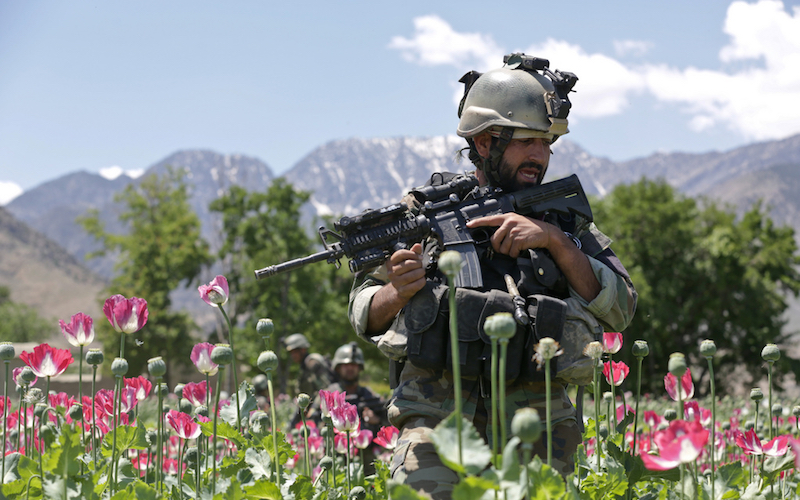
How the Arrival of ISIS Further Complicates Afghanistan
On 29 June 2015, it was the first anniversary of the establishment of a ‘caliphate’ by the Islamic State, also known as the ISIS, ISIL or Da’esh. The Islamic State today holds a territory roughly equal to the size of the UK and commands a force of 30,000 fighters, besides being a fast growing ideological brand. It collects taxes and, according to some reports, has its own currency.
Throughout the past one year or more, IS has shown no hesitation in aggressive expansion – in terms of capturing territory on the ground, inspiring terrorism, and spreading its ideology across the world through a well-funded web and social media campaign. According to the 2014 Global Terrorism Index, it is one of the few terrorist groups that are responsible for the majority of death and destruction caused by terrorism in the past year. It has attracted youth from over 100 countries to join its ranks in Iraq and Syria, and inspired several other terrorist groups to swear allegiance to it including those which were previously associated with the Al-Qaeda. It has claimed attacks in Libya, Egypt, Nigeria, Algeria, as well as the recent bombing of a Shiite mosque in Kuwait and the concomitant ‘lone wolf’ attacks in Tunisia and France. Further, IS has threatened those Islamic organisations which it feels have not been stringent enough in their religious enforcement, such as Hamas in Palestine.
It is not hard, therefore, to predict similar gains for IS in the war torn Afghanistan. To those young Taliban fighters who may be disillusioned or marginalised by their leadership, IS offers a new brand of extremism.
The Islamic State thus wasted no time before it begun tapping into this potential in Afghanistan, just as it did elsewhere. In December 2014, the group made it clear that it would expand into the Afghanistan-Pakistan region. In January this year, it was declared that the IS will establish the Khorasan province in the region as part of its larger caliphate. It even announced the leadership that would take the movement forward.
There have been several incidents involving the IS-affiliated militants in Afghanistan, who have been fighting against both the Afghan security forces and the Afghan Taliban, since the Khorasan declaration. The eastern Nangarhar province has emerged as the hotbed of Islamic State’s activity, where there have been heavy clashes between the Taliban and IS-affiliated militants. On June 16, the Taliban in a letter addressed to Abu Bakr al-Baghdadi warned IS to stay out of Afghanistan. It insisted that that the jihad against the Americans and their allies must be conducted under “one flag and one leadership” and urged IS to stop recruiting in Afghanistan.
The Afghan government has also been taking note of IS related activity. President Ghani has constantly articulated, especially during his foreign visits, the need to check the rise of IS in Afghanistan. The National Directorate of Security (NDS) formed a Special Force to exclusively combat IS and has seen at least some successes since then. The US’s drone strikes have also been successful in targeting and killing IS commanders and fighters.
But with the weakening of Taliban following the confirmation of ‘Amir-ul Momineen’ Mullah Omar’s death, IS has got an opportunity to bounce back. While Mullah Akhtar Mohammad Mansoor has been declared as the new supreme leader of Taliban, a section within the Taliban wants Mullah Omar’s son Mullah Yaqoob to be the successor instead. This growing rift between the Taliban cadres might lead to a breakup of the group which would allow the Islamic State to re-launch itself among the young Taliban fighters and carve out its own sphere of influence in the region. The IS has in fact already claimed a breakthrough in its efforts to gain a foothold in Afghanistan. Their spokesman for Khorasan province has claimed that pledges of allegiance to Islamic State are taking place across the country.
The Islamic State’s trajectory in Afghanistan would be clearer once the current fighting season ends and different parties of the conflict take stock of the damage suffered and gains made. However, if the recent trends are any indicators of the future, the security situation in Afghanistan is headed to take a complicated turn that would further test the resolve and already dwindling resources of the Afghan government and security forces.
The outreach to Pakistan that President Ghani embarked upon after coming to power has clearly paid no dividends, at least until now. Pakistan is unwilling to let go of its ‘strategic assets’ – in the form of various terrorist groups – any time soon, despite all the rhetoric that they support a stable Afghanistan. Violence continues to wreck people’s lives in almost every corner of the country even as the so called talks with Taliban are underway, raising fundamental questions on the effectiveness of such engagements to bring any peace. In fact this year’s fighting season has turned out to be the bloodiest ever, with the Taliban carrying out attacks and taking control of several districts even in the north. Stepping into such turmoil is another deadly player, the Islamic State.
Saddled with challenges of corruption, illicit drug trade, illegal mining and pending electoral reforms, besides the rapidly deteriorating security situation across the country, the Afghan Unity government is finding it increasingly difficult to meet any of its objectives.

